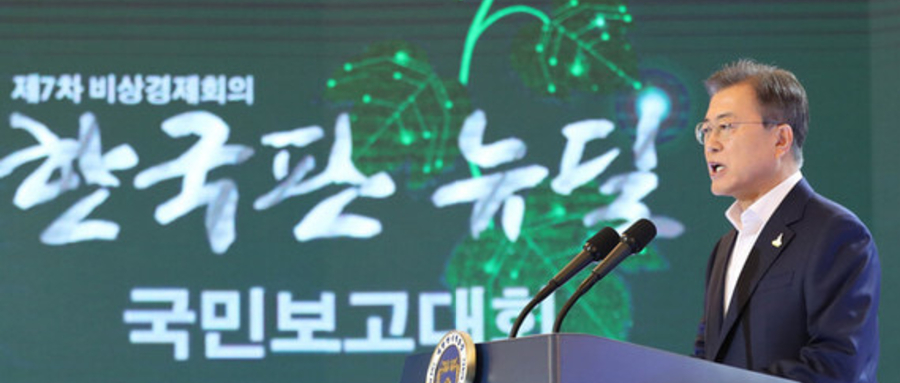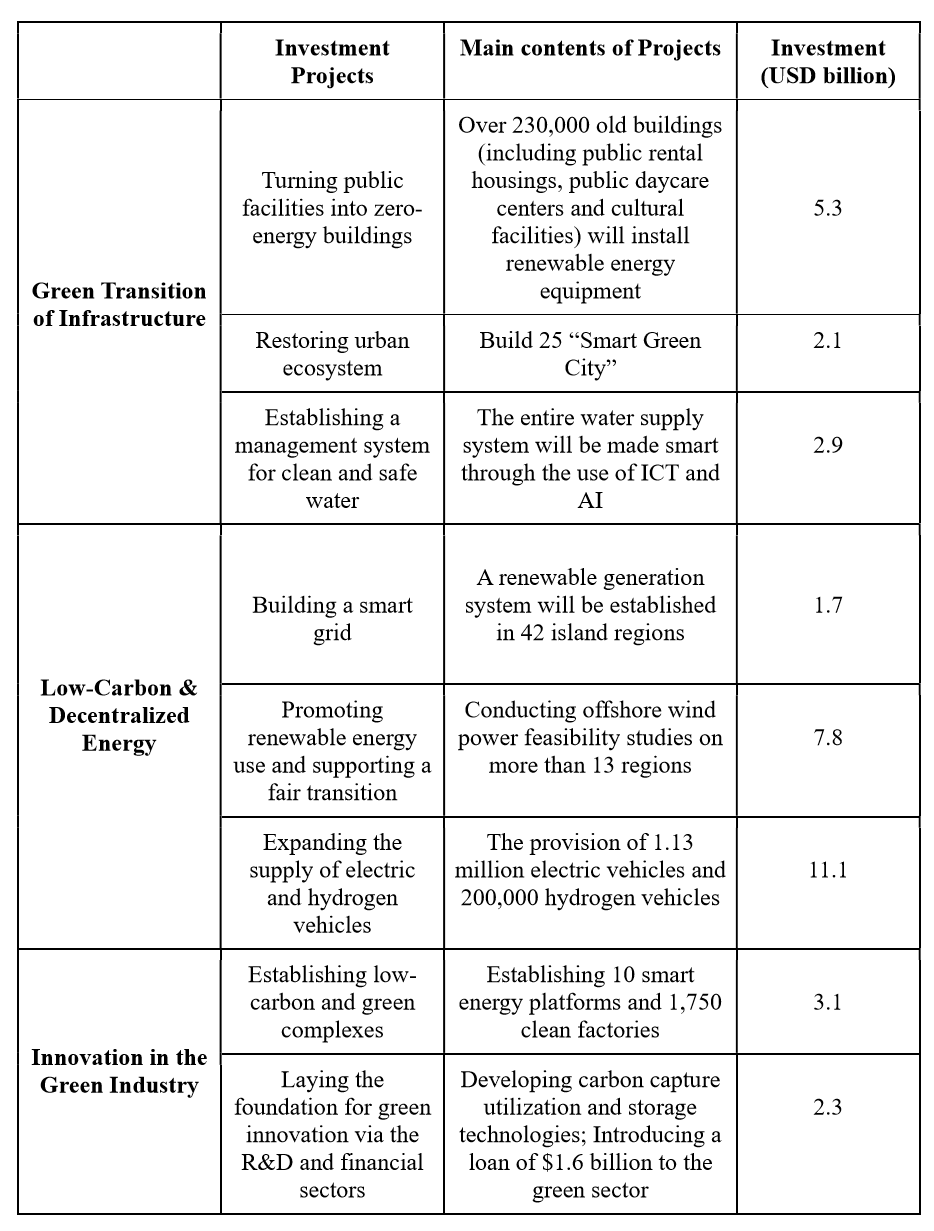

Like global economies, South Korea’s economy has also been severely hit by COVID-19. In particular, overseas market demand for South Korea’s major export products such as automobiles, semiconductors and machinery has dropped significantly. South Korean exports decreased by 24% year-on-year in May [1]. In addition, in order to reduce the operating costs of enterprises during the pandemic, South Korean enterprises cut nearly 400,000 jobs in April this year, and the unemployment rate increased by 0.5% year-on-year, with the wholesale and retail sectors having the highest unemployment rate [2]. In recent days, hundreds of people have even been standing on the streets of Seoul to find jobs in the early morning [3].
In response to the economic losses and rising unemployment caused by COVID-19, the South Korean government issued a five-year national strategic plan (2020-2025) called the “Korean New Deal” in July this year. The plan mainly includes three areas, namely “Digital New Deal”, “Green New Deal” and “Stronger Safety Net” (Table.1). This article will focus on the “Green New Deal”.
Table 1. “Korean New Deal” National Strategic Plan. [4]

![]()
South Korea's “Green New Deal”:
Among the “Korean New Deal”, the “Green New Deal” has the largest investment. It will be used to help South Korea achieve its goal of shifting from a high-carbon economy to a low-carbon economy, mainly including “Green Transition of Infrastructures”, “Low-carbon and Decentralized Energy”, and “Innovation in the Green Industry” (Table.2).
Table 2. Main contents and investment plan of South Korea’s "Green New Deal". [5]

According to Table 2, South Korea’s “Green New Deal” mainly focuses on the development of green industries such as renewable energy. Expanding the use of renewable energy and new energy vehicles are the two core contents of the “Green New Deal”. The South Korean government is expected to invest $7.8 billion and $11.1 billion respectively by 2025.
Compared with the EU’s “Green Recovery Plan”, South Korea’s “Green New Deal” will not only provide financial support of different scales in terms of building renovation, renewable energy and clean mobility, but will also support the innovation of the green industry, including investment in the entire process of environmental and energy enterprise project development (from R&D, testing, to commercialization) and the establishment of low-carbon and green complexes. Promoting the innovation and development of green industry will help the South Korean government gradually shift to a low-carbon industrial structure while creating 63,000 green jobs.
South Korea's “Green New Deal”:
Can’t change South Korea's coal-dependent economy
In general, South Korea's “Green New Deal” is relatively rough. It only sets specific targets and investment amounts in three areas, without detailed specific response measures. Although the “Green New Deal” mentions the development goals of renewable energy and other green industries, it lacks the commitment and timeline to phase out coal. South Korea is highly dependent on coal and currently has about 60 coal-fired power plants in operation, which accounted for 40% of the national power generation in 2019, while renewable energy only accounted for 6.5% [6]. In addition, coal-fired power generation is also one of the major sources of greenhouse gas emissions in South Korea. Currently, the greenhouse gas emissions generated by existing coal-fired power plants account for one-third of total greenhouse gas emissions [7]. Therefore, South Korea's "Green New Deal" should also include the coal phase-out plan to reduce greenhouse gas emissions from the source.
Moreover, South Korea’s “Green New Deal” does not mention stopping funding domestic and overseas coal projects, which runs counter to South Korea’s climate commitment to gradually cancel its domestic and overseas coal financing. The South Korean government has pledged to aim for a net-zero emissions society, but still backed a $3 billion in emergency support to troubled domestic coal power company Doosan Heavy Industries. At present, Doosan Heavy Industry has not announced its own economic recovery plan, but it is South Korea’s flagship coal plant manufacturer. These emergency loans may encourage Doosan Heavy Industry to invest in coal-fired power projects overseas [8]. In addition, Korea Electric Power Corporation (KEPCO), the largest state-owned power company in South Korea, will invest $51 million in a coal-fired power project in Indonesia [9]. In October 2020, KEPCO’s board approved an investment of $189 million on a 40% stake in a coal power project in Vietnam [10]. Currently, South Korea mainly invests in coal-fired power projects in Southeast Asian countries, such as Vietnam and Indonesia, but both two countries are developing renewable energy and coal-fired power projects have received protests from local environmental groups.
Furthermore, South Korea’s “Green New Deal” is inconsistent with the ruling Democratic Party’s promise ahead of the legislative election in April this year. In the climate manifesto published by the Democratic Party, the “Green New Deal” will include large-scale investment in renewable energy, the introduction of a carbon tax, and the phase out of domestic and overseas coal financing by public institutions [11]. However, the “Green New Deal” only includes increasing investment in renewable energy, and it remains to be seen whether the South Korean government will include other commitments in the “Green New Deal”.
Conclusion
South Korean President Moon Jae-in recently announced that 10 existing coal-fired power plants will be closed by the end of 2022 and another 20 by 2034. However, seven new coal power projects remain under construction as of 2020. Although South Korea’s “Green New Deal” has yet become truly green, there may be follow-up measures that raises the country’s climate action ambition. REEI will also continue to follow the latest developments in South Korea’s “Green New Deal” and will provide you with independent and objective insights.
Notes:
[1] Business Korea, “COVID-19 crisis drags down auto industry’s contribution to Korea’s exports”, link: http://www.businesskorea.co.kr/news/articleView.html?idxno=47152
[2] The Korea Herald, “S. Korea suffers steepest job losses in 10 years amid pandemic”, link: http://www.koreaherald.com/view.php?ud=20200610000707
[3] 央视网, link: http://tv.cctv.com/2020/09/19/VIDEtqqLdAwbnfROSHds6Rjh200919.shtml
[4] Government of the Republic of Korea, “Korean New Deal”, pp15, link: http://english.moef.go.kr/pc/selectTbPressCenterDtl.do?boardCd=N0001&seq=4948
[5] Government of the Republic of Korea, “Korean New Deal”, pp26-31, link: http://english.moef.go.kr/pc/selectTbPressCenterDtl.do?boardCd=N0001&seq=4948
[6] China Dialogue, The substance of a Korean Green New Deal is still being defined, link: https://chinadialogue.net/en/climate/the-substance-of-a-korean-green-new-deal-is-still-being-defined/
[7] Climate Home News, South Korea urged to exit coal by 2029 to stick to Paris climate agreement, link: https://www.climatechangenews.com/2020/02/20/south-korea-urged-exit-coal-2029-stick-paris-climate-agreement/
[8] Pulse, Doosan Heavy I&C gets another $1bn, raising total state bailout to near $3 bn, Link: https://pulsenews.co.kr/view.php?year=2020&no=564186
[9] Climate News Network, South Korea backtracks on green promise, link: https://climatenewsnetwork.net/south-korea-backtracks-on-green-promise/
[10] Climate Home News, South Korea pursues Vietnamese coal plant, drawing international criticism. link: https://www.climatechangenews.com/2020/10/05/south-korea-pursues-vietnamese-coal-plant-drawing-international-criticism/
[11] Climate Home News, South Korea to implement Green New Deal after ruling party election win, link: https://www.climatechangenews.com/2020/04/16/south-korea-implement-green-new-deal-ruling-party-election-win/
Author: Yating Yuan
Proofread: Ang Zhao and Jiaqiao Lin
Translation: Lu Ye (Intern)
The above content is the author's personal views, do not represent the position of REEI, please contact us to obtain the appropriate authorization to reprint.
For cooperation and authorization, please send email to: liying@reei.org.cn
* This is the translation of an article in Chinese. Should there be any inconsistency between Chinese and English version, the Chinese version shall prevail.




